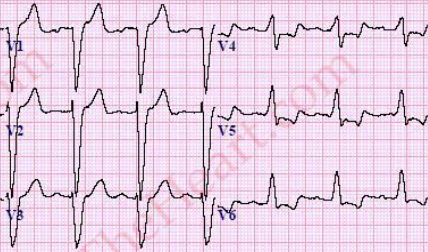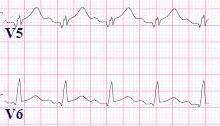ECG Reviews
Left Bundle Branch Block (LBBB) ECG Review
The ECG criteria for a left bundle branch block include:
- QRS duration greater than 120 milliseconds
- Absence of Q wave in leads I, V5 and V6
- Monomorphic R wave in I, V5 and V6
- ST and T wave displacement opposite to the major deflection of the QRS complex
A simple way to diagnose a left bundle branch in an ECG with a widened QRS complex (> 120 ms) would be to look at lead V1. If the QRS complex is widened and downwardly deflected in lead V1, a left bundle branch block is present. If the QRS complex is widened and upwardly deflected in lead V1, a right bundle branch block is present. The image below shows the typical findings of a left bundle branch block in the precordial ECG leads.
Note: If the QRS duration is 100 to 119 ms with criteria 2, 3 and 4 of the above, an incomplete LBBB is present.
A rate-dependent LBBB can occur at times of fast heart rates. This may be caused by myocardial ischemia or refractoriness of the left bundle at faster heart rates. When occurring at heart rates greater than 100 beats per minute, a rate-dependent LBBB can at times be difficult to distinguish from ventricular tachycardia because both cause a wide complex QRS complex. The Brugada Criteria for diagnosing ventricular tachycardia is helpful to make this distinction.
The ECG strip below shows normal sinus rhythm, then atrial fibrillation with a rapid ventricular response develops. With the faster heart rate, the QRS complex morphology changes to that of a LBBB. As sinus rhythm restores, and the ventricular rate slows, the QRS morphology returns to normal.
Sgarbossa Criteria
The Sgarbossa criteria is used in the diagnosis of an acute myocardial infarction when a LBBB is present.
Traditionally, it has been taught that MI is not able to be diagnosed via ECG in the presence of a LBBB. However, Sgarbossa et al described in 1996 some ECG changes seen in patients with LBBB and concomitant MIs and devised a point scoring system. This is called the Sgarbossa criteria, and they are listed below.
- ST segment elevation > 1 mm and in the same direction (concordant) with the QRS complex = 5 points
- ST segment depression > 1 mm in leads V1, V2 or V3 = 3 points
- ST segment elevation > 5 mm and in the opposite direction (discordant) with the QRS = 2 points
A score of 3 points is required to diagnose an acute MI. Criteria #3 is under debate as to its usefulness; therefore, either criteria 1 or criteria 2 are essentially required. This patient just made 1 mm ST segment elevation in lead V5 and about 0.5 mm ST elevation in V6 — an ECG indeed from a patient with an acute left anterior descending thrombosis.
Note: Cabrera’s sign and Chapman’s sign have also been used to diagnose acute MI in the setting of a LBBB. Examining the T wave in leads V5 to V6 can be helpful, as well. In the Sgarbossa study, there was a 26% sensitivity to detect acute MI when the T wave was upright rather than inverted.
ECG Examples:
- Incomplete Left Bundle Branch Block ECG
- Left Bundle Branch Block - Cabrera’s Sign ECG
- Left Bundle Branch Block - Chapman’s Sign ECG
- Left Bundle Branch Block ECG (Example 1)
- Left Bundle Branch Block ECG (Example 2)
- Left Bundle Branch Block ECG (Example 3)
- Left Bundle Branch Block ECG (Example 4)
- Left Bundle Branch Block ECG (Example 5)
- Left Bundle Branch Block ECG (Example 6)
- Rate-Dependent Left Bundle Branch Block ECG
References:
1. Chou’s Electrocardiography in Clinical Practice: Adult and Pediatric, 6e
2. Sgarbossa EB et al. Electrocardiographic Diagnosis of Evolving Acute Myocardial Infarction in the Presence of a Left Bundle Branch Block. N Engl J Med 1996;doi:10.1056/NEJM199602223340801.
3. Surawicz B, et al. AHA/ACCF/HRS Recommendations for the Standardization and Interpretation of the Electrocardiogram. Circulation. 2009;doi:10.1161/CIRCULATIONAHA.108.191095.



